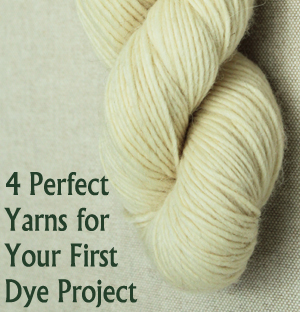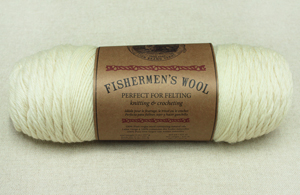 Dyeing your yarn is a great project for the warmer months of the year, and can blossom into a hobby that you’ll enjoy year round! When you want to try dyeing your own yarn, here are a few tips that will help you choose the yarn, dye and tools you’ll need to have a successful project:
Dyeing your yarn is a great project for the warmer months of the year, and can blossom into a hobby that you’ll enjoy year round! When you want to try dyeing your own yarn, here are a few tips that will help you choose the yarn, dye and tools you’ll need to have a successful project:
What tools to use? The first step in dyeing is assembling the right materials. Make your you have a non-reactive pot to heat the dyebath in (try steel or enamel pots), tongs to move the yarn, and protective covering/clothing in case of spills. If you’re working with kitchen-safe dyes, then you can use the pots you cook with, but in general it’s a good idea to have a separate set for dyeing.
100% Natural, or Fiber Blends? You’ll want to pick something with a high percentage of natural fiber in its composition. Blends of natural and acrylic fibers can take dye well, but will often have a different appearance.
Plant or Animal Fibers? Animal fiber (or keratin fiber) such as wool, alpaca, cashmere and angora, takes most natural and man-made dyes well. Plant fiber (or cellulose fiber) like cotton or bamboo can also be dyed, but requires specific compounds to bind to the fiber. Animal fibers are particularly easy to work with when you’re just getting started because they will respond to many kitchen-safe dyes. Whatever fiber you use, be sure to check that your dye is appropriate.
Color? In the beginning, it’s a good idea to use natural or very pale/white yarn for dye projects. As you get more comfortable with dyes and color, you may want to try over-dyeing, a process in which you dye a fiber that has been dyed before.
 |
Pure WoolPart of our line of affordable, luxury fibers, this 100% undyed wool roving yarn is spun in the USA, from fiber from American-raised sheep. This natural yarn has great texture and is perfect for hand-dyeing, as well as felting. Note: this one you’ll have to buy online as the LB Collection is not available in stores. |
 |
Sock-EaseFingering-weight sock yarn is great for socks or lacy accessories, and the Marshmallow shade of Sock-Ease is a great neutral tone for dyeing. This yarn is a wool blend, but there is more than enough wool to take the dye. |
 |
Superwash Merino CashmereThis worsted-weight yarn is super soft, and a great candidate for a dye project. Some people even find that the superwash treatment this yarn is given in the factory helps it take up more color from dye. This treatment will also prevent felting during the dyeing process. |
 |
Fisherman’s WoolMade of un-dyed pure virgin wool with natural lanolin oil, this 100% wool is ideal for ski-wear, sweaters, hats and scarves. Its generous yardage per ball and natural shades make it a perfect yarn for dyeing! |
Have you ever dyed your own yarn? what tips would you share with a beginner?
Related Links:
calenia
I have dyed the sock-ease, fisherman’s wool, and also the LB superwash merino in antique with great results. have used Koolaid, jacquard, and dharma acid dyes.Be prepared to experiment as you may not get what you wanted but it could surprise you and be beautiful. There are several great dying groups on ravelry that have tons of pictures and technique help. Grace at the Lion Brand studio teaches great classes in dying too.
Portialee13
I’ve just finished my first hand dyed and felted project and it’s perfect. Â I used fisherman’s wool , food dye, and crocheted. Â I got most of my instruction from a myriad of You Tube videos. Â “Try it you’ll like it”!!!!
VirginiaM
I’ve dyed yarns using cake dyes, koolaid, Easter egg dyes and just recently started using Jacquard dyes. The main thing is not to be afraid to dye yarn. If you are not sure of the outcome then dye small sample skeins. You can even overdye commercially dyed yarns. Enjoy the process.